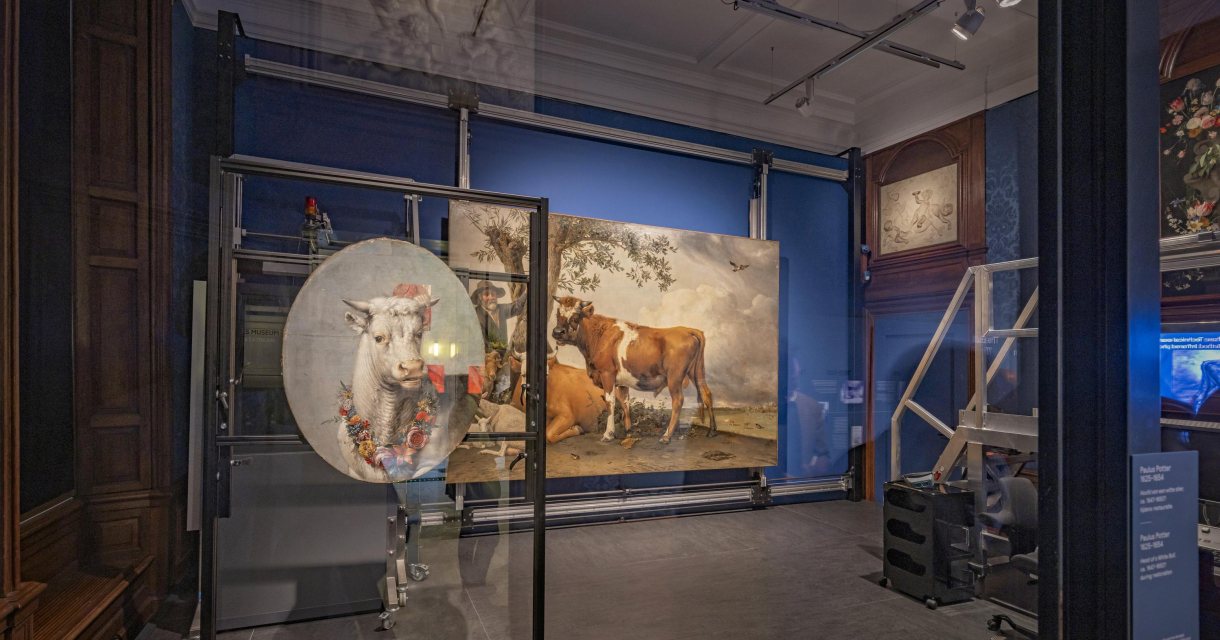Public restoration The Bull of Paulus Potter at the Mauritshuis
14 Oct - 1 Nov
Exhibition
Visitors can witness the research and restoration of The Potter Bull live. The monumental (largest!) painting in the Mauritshuis' collection was last treated 50 years ago. Since then, conservation, restoration and research techniques have boomed. The aim of the project, which will last a year and a half, is to gain new insights into Paulus Potter's painting technique and working methods. In addition, with this restoration, The Bull will be even better preserved for future generations.
Glass wall
The painting moves to another room, which is set up as a studio for research and restoration. Through a glass wall, the public can almost daily see the restorers at work with their scientific equipment. Between 29 March and the end of May, research on the painting will first take place, after which work on the extensive restoration can start from the beginning of June. The restoration is likely to take until autumn 2025.
PotterViewers - The bull under the microscope, Room 2 Mauritshuis
- 29 March - end May 2024: research phase (public)
- Early June 2024 - autumn 2025: restoration (public)
Air party
The research and restoration will hopefully answer several questions. On a smaller painting, Potter probably painted only one animal - just the bull - and then enlarged the canvas on three sides and added the rest of the representation. It is unknown how he did this. The originally blue sky has been discoloured and damaged over the centuries, and is therefore in worse condition than the rest of the painting. These damages were covered by overpainting during many previous restorations. The aim of the conservators is to bring back not only this sky part ij, but also the work as a whole, as close as possible during their work to how Potter intended it in 1647, when the painting was just finished.
Discovery
During preliminary research, it came to light that the National Gallery of Ireland (Dublin) owns a painting that can be linked to The Bull. Mauritshuis conservator Jolijn Schilder discovered that Potter once painted a large painting (approx. 2.10 m x 1.70 m) depicting The Roof of Europe, of which the oval painting the Head of a White Bull appears to be a fragment. A significant part of the painting has been lost, with only the fragment remaining. The two bulls are different in colour, but the way the heads are depicted show strong similarities. As a result, the 'Irish' bull will be invaluable for research into the 'Dutch' bull. The material technical and art historical research on Head of a white bull is a collaboration between the National Gallery of Ireland and the Mauritshuis. Both bulls will be on display during the research at the Mauritshuis between March and May 2024.
Techniques
For the upcoming project, the conservators, in collaboration with researchers from the Rijksmuseum, are pulling out state-of-the-art techniques. X-ray equipment, infrared imaging, X-ray fluorescence measurements, thread counting, canvas analysis, pigment and layer build-up analysis and digital (3D) microscopy should help unlock as many secrets of the world-famous canvas as possible.
Royalty
Paulus Potter's bull is among the paintings that were on public view immediately when the Mauritshuis opened as a museum in 1822. In the 19th century, before the Girl with a Pearl Earring was added to the collection, The Bull was the reason to visit the Mauritshuis. What makes the painting so special is that Potter depicted something as ordinary as a bull, a peasant and other animals in this huge format. In the 17th century, only Biblical and mythological subjects and royalty were depicted so large and 'distinguished'. And despite the size, the painter also paid very close attention to the smallest details, such as the lark in the sky, the sunlight on the meadow and the flies around the bull's back. In later centuries, The bull rightly became the icon of Dutch naturalist painting.
Families and children
A small presentation will accompany the research and restoration, including a historical timeline of the life of The Bull. For families and children, there will be an interactive digital audience guide during the research and restoration. Once a week, visitors can ask the conservators questions about their work.
Dates and Times
| Monday |
13:00 – 18:00
|
| Tuesday |
10:00 – 18:00
|
| Wednesday |
10:00 – 18:00
|
| Thursday |
10:00 – 18:00
|
| Friday |
10:00 – 18:00
|
| Saturday |
10:00 – 18:00
|
| Sunday |
10:00 – 18:00
|
